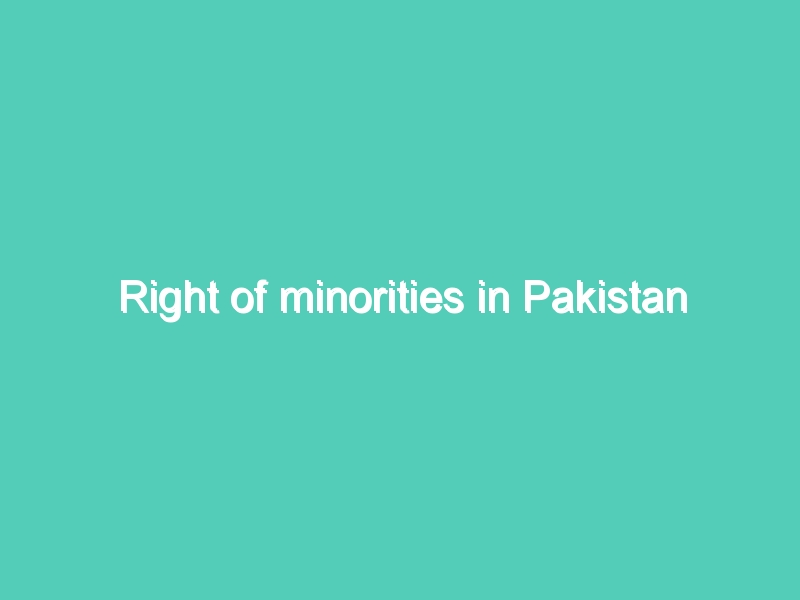Pakistan got its way of life as a different country on August 14, 1947. In those days, Pakistan additionally included present-day Bangladesh which was known as East Pakistan. These two domains were cut out as another free country with Islam as its state religion. There is no bona fide and dependable authority information on the strict piece of Pakistan’s populace in 1947. Pakistan’s populace is by and large assessed to be c. 142 million, albeit as per the official registration reports it is c. 137 million.[1] As indicated by the statistics of 1981, out of an aggregate of 84,253,644, Muslims represented 81,450,057; trailed by 1,310,426 Christians; and 1,276,116 Hindus. Ahmadis represented 104,244; Parsis 7,007; Buddhists 2,639; Sikhs 2,146; and ‘others’ 101,009. In light of a de-accentuation on family arranging, and the appearance of a great many Afghan and some Iranian outcasts, populace development inside the nation has been colossal. In 1990, it was evaluated that the minorities were 3.1 percent of the complete populace. As indicated by these evaluations, there were 1,769,582 Christians in Pakistan; 1,723,251 Hindus; 9,462 Parsis; 3,564 Buddhists; and 2,898 Sikhs, while the ‘others’ all things considered were assessed to be 13,640. The all out figure for the minority populace was c. 3,663,167. After two years, the total figure remained at 4,267,463; with Christians and Hindus practically equivalent at 2,061,306 and 2,007,743, individually. The Ahmadis, Parsis, Buddhists, Sikhs and others were evaluated to be 163,982; 11,021; 4,150; 3,374; and 15,888, separately.
It is intriguing to take note of that even the Parsis, regardless of some outward movement, had enrolled a slight increase.23 The registration of 1998 demonstrated the minorities approaching 11–13 million. Ahmadis, Christians and Hindus guarantee to have a populace of 4 million every It is pivotal, in any case, to take note of that, given the weaknesses and belittling, networks don’t prefer to be distinguished as minorities so the previously mentioned figures might be an under-gauge, as certain individuals might not have decided to recognize their ethnic or strict foundation
.
There are commonly no populace figures accessible for Pakistan’s littler minority networks. Generally, minorities speak to c. 8 percent of the complete populace. Pakistani minorities comprise of Ahmadis, Bahais, Buddhists, Christians, Hindus, Jains, Kalasha (of Chitral), Parsis and Sikhs. Aside from the Ahmadis, they all concede to their being non-Muslim. Inside these networks there are rank based, class-based and denominationbased divisions; alongside age, ethnic, sexual orientation, provincial and urban qualifications. Any shallow order is available to contest. For instance, among the 4 percent of the Pakistani populace who are Christian, there is a right around 50-50 separation between the Catholic and the Protestant sections. Urban communities like Peshawar, and regions of Bahawalpur, Hyderabad, Rawalpindi and Quetta, have consistently had a sizeable number of Christians occupied with different callings in the administration part. The congregation association is fundamentally the same as other South Asian nations with a distinct Pakistani social and phonetic epitome, and there are changes over, relatives of changes over, Anglo-Indians/ – Pakistanis, and Western teachers. Hindus are equal in number to the Christians, with very nearly 4 percent of the populace. There are a few stations among the Hindus, other than ethnic assorted variety. [2]More than 65 percent of the minority populace are youngsters, and the normal education rate in a couple of cases is higher than the national normal; be that as it may, different realities are not all that satisfying. As of now referenced, for the littler strict minority networks – including Buddhists and Jains – there are no measurements, and minimal dependable data. They are known to be minuscule gatherings who want to stay out of the open eye. Ahmadis have been the focal point of consideration because of the issue of their confidence. Intermarriage and open social collaboration stay insignificant. Numerous Ahmadis neither straightforwardly declare their personality nor gather obviously, in order to evade threatening consideration. The Ahmadis are separated into the Lahori and Qadiani gatherings. The greater part of their spread exercises have moved toward the West. The Sikhs are again for the most part Punjabis with littler traditional communities in Karachi and NWFP.
There are a RELIGIOUS MINORITIES IN PAKISTAN 11 barely any Sikhs in the innate territories who are bilingual and have a cozy relationship with Sikhs in Afghanistan. During the Taliban’s power, numerous Afghani Sikhs relocated abroad, with only a modest number coming to Pakistan. The Sikhs remain sensibly secure contrasted and different strict networks, as most famous disdain is held for Christians and Hindus. Parsis are carefully a urban and enterpreneurial network situated in Karachi and Lahore, with a couple of families in other significant urban communities. Because of their solid business interfaces, the non-fervent nature of their confidence and a consistent outward relocation to North America, the Parsis stay ‘less obvious’ in Pakistan, and there are no reports of provocation or outrage explicitly coordinated against them.. Since the late nineteenth century, Kalasha (privately called ‘Kafirs’ also), have been feeling the squeeze to change over to Islam. Their division by the Durand Line – the Pakistan-Afghan outskirt – didn’t help.
During the 1890s, Amir Abdur Rahman, the strict King of Kabul, persuasively changed over a large number of the Afghan Kalasha to Islam. Some of them looked for insurance on the Pakistani side of the Line. Their detached, precipitous area and lifestyle has shielded them from outside impacts. Their ever-diminishing number is around 3,000 and even national measurements will in general disregard them. Notwithstanding, the vacation destination of their valleys in the Hindu Kush, their sex based balance and a developing accent on Islamic activism since the 1970s have put these little networks under a spotlight.
Introducing the information on strict structure of Pakistan in 1947 in his discourse, Home Minister Amit Shah didn’t make reference to his source either[3]. The artilce ‘Purging Pakistan of Minorities’ was composed by Farahnaz Ispahani, previous individual from Pakistan’s Parliament. Be that as it may, she also didn’t specify the wellspring of her figures. The previous figures on Pakistan’s strict creation that are accessible are from Census 1941. In any case, since it was directed in a unified India, alluding to it is purposeless as it doesn’t mirror the ground circumstance made soon after the bloodied Partition in 1947. After its arrangement, the primary enumeration in Pakistan was done in 1951. This enumeration included both East and West Pakistan.
According to this enumeration, the portion of Muslims in Pakistan’s general populace in 1951 was 85.80 percent, while the portion of non-Muslims was 14.20 percent. (Pakistan here alludes to East and West Pakistan taken together). What is imperative to note in Census 1951 is that Pakistan’s non-Muslim populace wasn’t equitably dispersed.
In West Pakistan, the non-Muslim populace was simply 3.44 percent, while in East Pakistan (the present Bangladesh) they had a noteworthy offer including 23.20 percent of the populace in that. According to Census 1951, portion of Muslims in Pakistan’s general populace was 85.80%, while portion of non-Muslims was 14.20%. To comprehend the adjustment in populace of strict minorities in present-day Pakistan, we have to independently dissect the patterns in West Pakistan and East Pakistan (presently Bangladesh). In 1951, Muslims involved 96.56 percent of the absolute populace in the region that is today known as Pakistan
The following statistics in Pakistan was completed in 1961 which said the non-Muslim populace in West Pakistan had decreased to 2.83 percent of West Pakistan’s all out populace.
By 1972 when Pakistan completed its third registration, East Pakistan had been freed and was currently known as Bangladesh. The 1972 evaluation shows non-Muslims in Pakistan contained 3.25 percent of the absolute populace. This was higher than their offer in 1961. When the following evaluation was done in 1981, Pakistan’s non-Muslim populace saw a miniscule ascent – from 3.25 percent in 1972 to 3.30 percent in 1981
In view of Pakistan’s evaluation information we find:
1) Population of non-Muslims was never 23 percent of Pakistan’s all out populace.
2) Even in unified Pakistan, portion of non-Muslim populace never at any point contacted the 15 percent mark. (The most noteworthy was 14.2 percent in 1951.)
3) When it goes to the present Pakistan (for example recent West Pakistan), non-Muslims included 3.44 percent of the locale’s populace in 1951.
4) Census information show that portion of non-Muslims in Pakistan has floated around 3.5 percent throughout the decades.
Having independently analyzed the pattern in populace change in the districts that are today known as Pakistan and Bangladesh, how about we look at the cases made by the BJP. The BJP has asserted:
1) Population of non-Muslims in Pakistan has decreased from 23 percent at the hour of Independence to 3.7 percent in 2011.
2) Population of non-Muslims in Bangladesh was 22 percent at the hour of Independence and has been decreased to 7.8 percent in 2011.
3) This decrease in populace portion of non-Muslims in these two Islamic nations was because of far reaching strict mistreatment.
There is no official information on the strict sythesis of Pakistan at the hour of Partition (at that point including the present Bangladesh). The nearest official figures accessible are from Census 1951. What occurred somewhere in the range of 1947 and 1951 is dependent upon singular understanding.
Thousands of non-Muslims were mistreated in Pakistan at the hour of Partition in 1947 (similarly as a huge number of Muslims were aggrieved in India). Other than this, a great many Hindus and different strict minorities left Pakistan and entered India in 1947 and thousands of Muslims left India to become Pakistani residents. This boundless movement and killings altered the strict organization of the locales worried in contrast with the circumstance before Partition. In any case, the specific size of these oppressions and movement stays obscure without information, and subsequently the populace portion of non-Muslims in Pakistan in 1947 stays obscure.
Taking Pakistan’s Census 1951 as benchmark for our examination[4], we find that while raising the issue of strict oppression in Pakistan and Bangladesh, the BJP stirred up information for the two districts.
Right off the bat, it said non-Muslims once involved 23 percent of Pakistan’s populace. The reality rather is that non-Muslims involved 23 percent of just East Pakistan’s populace, not the whole nation. Taken together (East in addition to West Pakistan), portion of non-Muslims was 14.20 percent (the most noteworthy ever) in 1951.
Furthermore, the BJP asserted that portion of non-Muslims decreased from 23 percent to 3.7 percent in Pakistan. This also is off base since portion of non-Muslims in Pakistan has drifted around 3.5 percent from the primary evaluation onwards.
1951: 3.44 percent
1961: 2.80 percent
1972: 3.25 percent
1981: 3.33 percent
1998: 3.70 percent
Thirdly, the BJP is right in saying that the rate portion of non-Muslims has diminished fundamentally in Bangladesh. However, it isn’t right in saying that the decay was from 22 percent to 7.8 percent. According to legitimate enumeration information, the decay was from 23.20 percent in 1951 to 9.40 percent in 2011.
Fourthly, BJP has contended that strict mistreatment was the purpose behind decrease of non-Muslim populace in Bangladesh. There is no denying that strict minorities were mercilessly aggrieved for a considerable length of time in East Pakistan and later additionally in Bangladesh. Hundreds of them were assaulted, killed and coercively changed over into Islam.
Yet, other than strict mistreatment, there were other solid factors that contributed in out-movement of non-Muslims from Bangladesh, which also brought about decay of their offer in populace.
Mistreatment dependent on language in Bangladesh and greener financial open doors in India have been solid push factors in Bangladesh for a huge number of unlawful outsiders who entered and settled in India. These illicit outsiders are Hindus, yet in addition include a sizable number of Bengali Muslims. Along these lines out-movement from Bangladesh has been a multifaceted wonder. Attributing it altogether to abuse of strict minorities is wrong.
This, in any case, doesn’t dismiss the way that strict minorities have been oppressed, assaulted and persuasively changed over in Pakistan and Bangladesh. In numerous cases, such indictment had unequivocal or unsaid endorsement of the legislature in power.
This was especially evident in during many years of military principle and much after 1971 when East Pakistan was freed and Bangladesh framed. In summation, apparently while supporting the reason for strict minorities in Bangladesh and Pakistan.
Article Written By- Simran Gupta
Law Student– Christ (deemed), to be university, Delhi NCR
(HRDI Work From Home Internship)
[1] Pakistan’s populace is by and large assessed to be c. 142 million, albeit as per the official registration reports it is c. 137 million. This is available at https://www.refworld.org/pdfid/469cbfc30.pdf (last visited at 7 may, 2020)
[2] ibid
[3] Introducing the information on strict structure of Pakistan in 1947 in his discourse, Home Minister Amit Shah didn’t make reference to his source either. This is available is that https://www.indiatoday.in/india/story/pakistan-bangladesh-non-muslim-population-citizenship-amendment-bill-bjp-1627678-2019-12-12
[4] ibid



